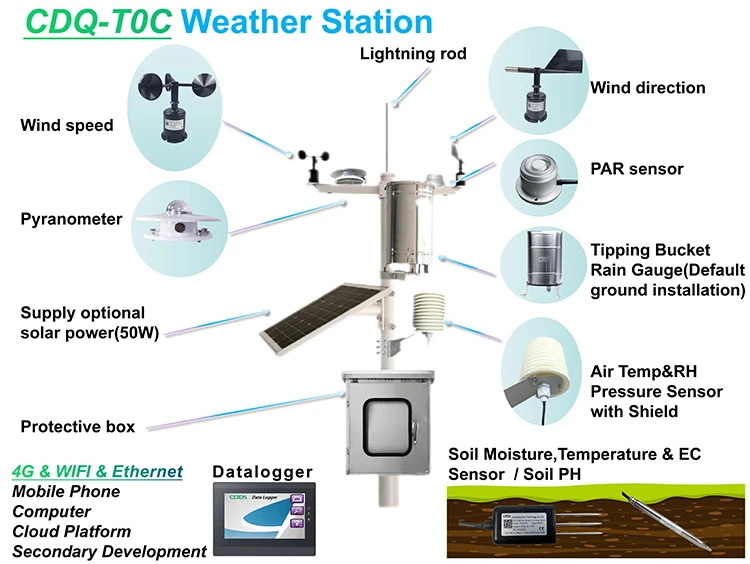An automated weather station (AWS) is a weather observation system. It collects, records, and sends various weather data automatically.This process does not need direct human help. This equipment usually includes several sensors.How much does an automatic weather station price?
These sensors measure key weather factors. These factors include air temperature, humidity, wind speed, and wind direction. They also track atmospheric pressure, rainfall, solar radiation, soil temperature, and moisture.
The sensors change physical changes into electrical signals. Data collectors then process these signals.
How Automatic Weather Stations Work:
The main part of an automatic weather station is its sensors and how it processes data.
The sensors capture environmental data. This data turns into electronic signals. Data loggers or controllers receive and store these signals.
Modern automatic weather stations often use advanced communication tools. These tools include 4G, satellite communications, and wireless networks.
You can look at the data and show it using a cloud platform or special software.
Automatic weather station equipment components:
Weather Sensor: used to measure certain weather conditions.
Data Collector: It processes sensor data and does the needed calculations and formatting.
Power supply system: Solar panels and batteries work together. They provide power in remote or off-grid areas.
Communication module: it sends data from a distance.
Protective devices include lightning protection and waterproof design. These features help keep the equipment running well in bad weather.
Brackets and mounting structures help keep the equipment stable. They can be used on the ground or on a tower.
How much does an automatic weather station cost?
The automatic home weather station includes places like campuses, farms, and the Internet of Things. Prices for portable weather stations vary. You should look at the price of automatic weather station equipment based on the type and its features. Next, we will provide a detailed introduction.
◉Price of agricultural automatic weather station
Meteorological monitoring stations for agriculture usually cost several thousand to tens of thousands of dollars. The exact price depends on the equipment’s features and performance. People often use the device to check things like soil temperature, humidity, nutrients, pH value, and current-carrying capacity. It collects this information automatically and sends it to the IOT platform.
◉Prices of campus automatic weather stations
Prices are usually a few thousand dollars. The automatic monitoring station is a common tool for checking the environment. Its price often depends on how the equipment is set up.
The school needs to decide how to set up its weather equipment based on its needs. Commonly monitored parameters include air temperature, humidity, air barometric pressure, light intensity, and more.
◉Internet of Things automatic wireless weather station price
The price of this type starts at thousands of dollars. The device has many high-precision sensors. It also has two power supply modes.
The IoT class uses a simple installation model. Anyone can put it together without training. IoT devices can collect data.
Technical advantages of automatic weather station:
High automation reduces labor costs. It also improves how quickly and clearly we collect data.
◉Strong resilience: able to work in different weather conditions, even in extreme environments.
◉Remote monitoring means accessing and analyzing data from a distance. This helps manage multiple sites effectively.
◉High accuracy and reliability: Modern sensors provide accurate data. This is important for scientific research and practical uses.
Application areas of automatic weather station:
Farmers can use data from weather stations to make better choices about irrigation, planting, and harvesting. By knowing local weather patterns, they can improve crop yields and cut down on waste.
– Environmental Monitoring: Researchers and environmental activists rely on these stations to track climate changes, air quality, and other ecological factors. This data is crucial for studying the impacts of climate change and developing conservation strategies.
– Urban Planning: City weather enthusiasts planners can use weather data to build better infrastructure, manage energy use, and enhance public safety. Knowing local weather trends helps create stronger urban areas.
– Transportation: Airlines and shipping companies rely on accurate weather information. This helps them plan their routes and schedules. It keeps people safe, makes operations more efficient, and reduces costs.
– Research and Education: Schools and research groups use automatic weather stations for many studies. Students and researchers can access real-time data. This helps them understand meteorology and environmental science better.
In summary, automatic weather stations are very useful tools in many areas. They provide accurate, real-time data that helps with decision-making. This also improves our understanding of the environment.
Many places use automatic weather stations. These stations help with weather forecasting, farming, and monitoring the environment. They also improve safety in aviation and navigation.
They are also important for city planning and disaster alerts. Scientists use them for research and teaching. This helps collect data more efficiently and accurately. It also gives real-time and reliable weather information to support decision-making.
Smart campuses, smart agriculture, and smart forestry use weather observation tools. We need to analyze the cost of this equipment carefully. This analysis should look at different environments, parameters, and other important information.
For more information about weather stations measure, please contact us. Thank you!
